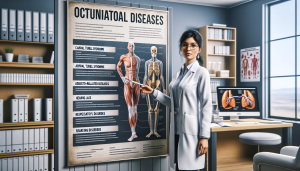Occupational diseases are a pressing concern in today's modern workplace, impacting countless individuals across various industries. These conditions, often referred to as work-related illnesses or workplace illnesses, exert significant influence on employees' health and their ability to sustain their livelihoods.


Common Types of Occupational Diseases
Within the spectrum of health issues that qualify as occupational diseases, some of the most prevalent include industrial diseases induced by prolonged exposure to hazardous chemicals or materials. Repetitive strain injury, commonly observed in both office and manual labor settings, is another frequently reported ailment. Additionally, asbestos-related diseases continue to pose a grave threat, particularly to workers in the construction and manufacturing sectors.
Identifying Workplace Illness
Recognizing the symptoms of workplace diseases represents the initial step in addressing this issue. Symptoms can span a broad range, from respiratory problems to skin conditions, contingent upon the nature of exposure to harmful substances in the workplace. Employees must maintain vigilance regarding changes in their health that might be attributable to their work environment.The Link Between Work Environment and Health Issues
The relationship between one's occupation and potential health problems is of paramount importance. Job-related health issues can stem from various factors, encompassing subpar workplace ergonomics, exposure to toxins, and even job-related stress. These work environment-induced ailments underscore the necessity for employers to prioritize the well-being of their workforce.Legal Aspects of Occupational Illness Compensation
In the realm of occupational illness compensation, workers' compensation for diseases plays an instrumental role. These laws are crafted to provide financial support to employees afflicted by work-related illnesses. Navigating the intricacies of these legal avenues can be intricate, underscoring the importance of comprehending one's rights for a successful claim.The Process of Claiming for Work-Related Health Problems
Initiating the process of claiming compensation for work-related health problems entails a sequence of steps, commencing with the reporting of the illness to the employer and seeking a medical evaluation. Documentation assumes paramount significance in employee health claims, serving as indispensable evidence to substantiate the connection between the occupation and the medical condition.Challenges in Proving Employment-Related Sickness
One of the most formidable challenges in pursuing compensation is the task of substantiating that a given condition genuinely results from employment-related factors. The recognition of occupational hazard illnesses necessitates establishing a conspicuous link between the workplace and the ailment, which, at times, can prove elusive without substantial medical and occupational evidence.Preventive Measures for Work-Related Disease
Mitigating work-related diseases assumes far greater significance than treating them. Employers and employees alike ought to adopt a proactive stance in implementing strategies for the prevention of work-related diseases. These strategies include recurrent training on safe work practices and the proper utilization of protective equipment.
Resources and Support for Affected Workers
For individuals grappling with occupational illnesses, various resources and benefits are accessible. Occupational sickness benefits serve as a means of financial relief, while support groups and legal counsel can provide invaluable guidance through the intricate landscape of professional sickness claims.Conclusion
Comprehending the intricacies of occupational diseases and the process of claiming compensation assumes pivotal importance for anyone laboring in environments harboring health risks. By maintaining a state of informed vigilance and proactive engagement, workers can optimize their ability to safeguard their health and access the requisite support when confronting work-related illnesses.Look for an attorney who has the right legal resources for your legal needs.
Contact us here on the Warmuth Law website or through our hotline 888-517-9888.











